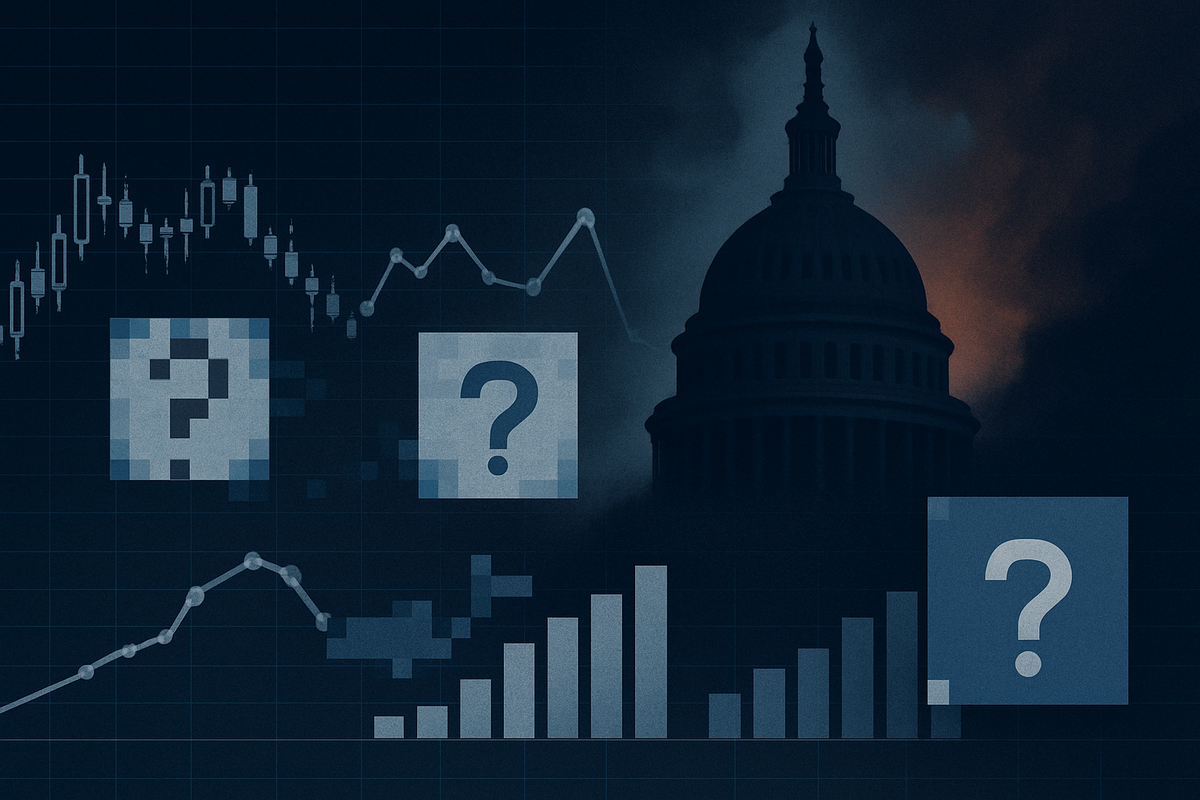
Washington D.C. – October 20, 2025 – Financial markets are holding their breath as the highly anticipated U.S. Consumer Price Index (CPI) report, a crucial gauge of inflation, remains delayed amidst an ongoing federal government shutdown. Originally slated for release on October 15, the September 2025 CPI data is now expected on October 24, creating a palpable sense of anxiety among traders, investors, and policymakers grappling with an obscured economic landscape. The unprecedented confluence of a government funding lapse and a critical data blackout leaves the Federal Reserve, businesses, and consumers navigating a perilous environment of heightened uncertainty.
The delay in the CPI report, a cornerstone of economic analysis, underscores the far-reaching implications of the current government impasse. As the primary measure of inflation, the CPI provides vital insights into the cost of living and consumer purchasing power, directly influencing the Federal Reserve's (Fed) monetary policy decisions. With the U.S. economy facing persistent inflationary pressures and the Fed treading a delicate path between combating rising prices and supporting growth, the absence of timely and accurate data poses a significant challenge, potentially leading to misinformed policy actions and increased market volatility.
Data Blackout Deepens Economic Fog Ahead of Fed Meeting
The current situation is a direct consequence of the U.S. government shutdown, which commenced on October 1, 2025, due to a failure to pass appropriations bills. This funding lapse has forced the Bureau of Labor Statistics (BLS), the agency responsible for compiling the CPI, to furlough non-essential staff, disrupting its data collection and reporting functions. The September 2025 CPI report, which typically provides month-over-month and year-over-year changes in consumer prices, was initially scheduled for October 15 but was postponed. A partial recall of critical BLS personnel was authorized to ensure the September data's release by October 24, primarily to meet the statutory deadline for the Social Security Administration (SSA) to finalize 2026 Cost-of-Living Adjustments (COLAs) by November 1.
However, concerns are mounting regarding the integrity and timeliness of future economic releases. The collection of new price data for the October CPI report, usually due in November, has been largely halted since the shutdown began. This raises the serious prospect that the October CPI report could be significantly compromised in quality, or even entirely skipped, if the shutdown continues. This "data vacuum" is particularly problematic as the delayed September CPI release on October 24 will occur just days before the Federal Reserve's critical policy meeting, scheduled for October 28-29. While the Fed will have the September figures, the uncertainty surrounding subsequent data could severely complicate its forward guidance and interest rate decisions, especially given the market's intense focus on potential rate adjustments.
Key players involved include the Bureau of Labor Statistics (BLS), responsible for the data; the Federal Reserve, which relies on the data for monetary policy; the U.S. Treasury, managing government finances; and Congress, whose inability to pass a budget triggered the shutdown. Investors and consumers are the primary stakeholders bearing the brunt of the uncertainty. Initial market reactions have been characterized by increased volatility across equities, bonds, and currency markets, with traders increasingly relying on alternative, often less comprehensive, private-sector data sources to fill the void left by official statistics.
Companies Brace for Impact Amidst Inflationary Uncertainty
The delay and potential compromise of critical inflation data have significant implications for public companies across various sectors, creating both potential winners and losers depending on how the situation unfolds and what the eventual CPI data reveals.
Companies that could face headwinds include those in consumer discretionary sectors, such as retailers like Amazon (NASDAQ: AMZN) and Target (NYSE: TGT), and leisure companies. Prolonged uncertainty about inflation and interest rates can dampen consumer confidence and spending. If the delayed CPI report eventually reveals higher-than-expected inflation, it could signal further interest rate hikes or a prolonged period of high rates, increasing borrowing costs for businesses and consumers, thereby slowing economic activity. Similarly, technology companies like Microsoft (NASDAQ: MSFT) and Apple (NASDAQ: AAPL), which often rely on future growth prospects and access to capital, could see their valuations pressured by rising discount rates in a higher-interest-rate environment. Companies with significant debt loads could also suffer from increased financing costs.
Conversely, companies that might be relatively resilient or even benefit could include those in staples sectors, such as Procter & Gamble (NYSE: PG) or Walmart (NYSE: WMT), as demand for essential goods remains more stable regardless of economic uncertainty. Financial institutions like JPMorgan Chase (NYSE: JPM) or Bank of America (NYSE: BAC) might see mixed effects. While a weaker economy could impact loan demand, a higher interest rate environment could expand net interest margins, assuming they can manage credit risk effectively. Furthermore, companies with strong balance sheets and significant free cash flow may be better positioned to weather the storm of economic uncertainty and potentially acquire distressed assets at favorable valuations. The delay in data, however, makes strategic planning difficult for all, as the true inflationary picture remains opaque.
Broader Economic Implications: A Looming Policy Dilemma
The ongoing government shutdown and the resulting delay in critical economic data like the CPI extend far beyond immediate market reactions, posing a significant threat to broader economic stability and policy efficacy. This event fits into a trend of increasing political polarization impacting economic governance, where fiscal brinkmanship directly interferes with the smooth functioning of essential government services, including economic data collection.
The primary ripple effect is on the Federal Reserve's data-dependent monetary policy. Without reliable, timely CPI figures, the Fed's ability to accurately assess inflationary pressures and make informed decisions on interest rates is severely hampered. This "flying blind" scenario risks either an overreaction to incomplete data or an under-reaction to evolving economic conditions, potentially leading to policy errors that could exacerbate inflation or trigger an economic downturn. The uncertainty also impacts consumer and business confidence, potentially leading to reduced spending and investment, further slowing economic growth. Internationally, a prolonged U.S. government shutdown and economic data disruption can erode global confidence in the U.S. economy, affecting the dollar's stability and potentially causing ripple effects in global financial markets. Historically, past government shutdowns have demonstrated a direct link to reduced GDP growth, even if temporary, and a notable increase in market volatility. The 2013 shutdown, for instance, led to delays in a wide array of economic reports, creating similar periods of market uncertainty. This current event serves as a stark reminder of how political gridlock can directly undermine the foundational elements of economic policymaking and market efficiency.
What Comes Next: Navigating the Data Void
The immediate focus for markets will be the release of the September 2025 CPI report on October 24. While this will provide a much-needed, albeit delayed, snapshot of inflation, the greater concern revolves around the quality and availability of the October CPI data and other crucial economic indicators if the government shutdown persists.
In the short term, market volatility is expected to continue. A higher-than-expected September CPI could trigger a sharp reaction, reinforcing fears of persistent inflation and potentially leading to a more hawkish stance from the Federal Reserve at its meeting on October 28-29. Conversely, a softer reading might offer some relief but would still be viewed with caution given the uncertainty surrounding future data. Companies may need to implement strategic pivots, adjusting their forecasts and operational plans to account for a sustained period of economic opacity. This could involve tightening spending, delaying investment decisions, or focusing on core business resilience. Long-term possibilities depend heavily on the duration of the shutdown. A swift resolution could limit the damage, allowing data collection to resume and restoring confidence. However, a prolonged shutdown risks permanently compromising the quality of economic data, eroding the Fed's credibility, and fostering a more cautious, risk-averse investment climate. Market opportunities may emerge in oversold sectors or companies with robust fundamentals that can weather the storm, while challenges will arise for those heavily reliant on stable economic conditions and access to capital. Potential scenarios range from a quick political resolution leading to a rapid data catch-up, to a protracted shutdown resulting in significant economic contraction and a prolonged period of market disarray.
Wrap-Up: A Test of Resilience and Transparency
The delayed U.S. CPI release amidst an ongoing government shutdown represents a critical juncture for the financial markets and the broader economy. The core takeaway is the profound impact of political gridlock on economic transparency and stability. Without timely and accurate inflation data, the Federal Reserve's ability to conduct effective monetary policy is severely compromised, leaving investors and businesses to make decisions in an information vacuum.
Moving forward, the market will remain highly sensitive to any news regarding both the CPI release and the resolution of the government shutdown. Investors should watch closely for the September CPI figures on October 24 and any indications from the Federal Reserve regarding its assessment of inflation and its policy outlook at the upcoming meeting. Beyond that, the focus will shift to the political arena, with the swift resolution of the government funding crisis being paramount to restoring confidence and ensuring the integrity of future economic data. The lasting impact of this event could be a heightened awareness of the fragility of economic data flows and the critical importance of stable governance for market functioning. Companies and investors alike are being tested on their resilience and adaptability in an environment where fundamental economic signals are intermittently silenced.
This content is intended for informational purposes only and is not financial advice





